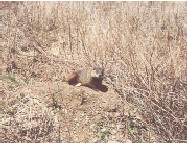
Woodchuck (Groundhog)
Marmotte commune
Status
Native to Labrador.
Habitat
Woodchucks inhabit well-drained open woods, pastures, fields, clearings and rocky ravines. Deforestation of eastern North America has helped the woodchuck to thrive.
Range
The woodchuck occurs in every province and territory, except for Prince Edward Island and the island part of Newfoundland.
Food
The woodchuck is primarily a grazer. It feeds on vegetative parts of plants, barks and twigs (if no green leaves are available). They are also fond of fruits and vegetables and will consume a few insects and young birds of ground-nesting species.
Predators/Threats
Hawks and rattlesnakes eat the young woodchucks; bobcats, coyotes, foxes and domestic dogs also prey on this species.
Lifespan
4 – 6 years.
Appearance
The woodchuck has a thickset body, flat head, not much of a neck, short, rounded ears and short, powerful limbs. The coat of a woodchuck is composed of two coats of fur. The underfur is thick and woolly on the flanks and the back; it is dark grey at the base and tipped by a buffy or cinnamon band. The relatively short bushy tail is dark brown or black. The feet are black. The ventral surface is covered with thin yellow-brown or rufous hairs. The cheeks and throat are brownish yellow; the forehead is brown and the small eyes are black. There’s only one moult per year.
Breeding Biology
Males are sexually active upon emergence from hibernation in March. Females mate soon after they emerge in April. After a gestation period of 31 to 32 days, the young are born in May. The litter size may vary between 1 to 9 (usually 4). The young woodchucks are weaned at about 6 weeks of age. They may breed as yearlings, at the age of eleven months, but most breed for the first time as 2-year-olds.
Average Weight/Measurements
The woodchuck’s total length is 18 to 25.7 inches; tail length is 4.1 to 6.4 inches; average weight of a groundhog is 4.9 to 14 pounds.
Notes:
- This animals is a focal point of folklore. It’s supposed to come out of its burrow each year on February 2 and forecast the weather for the following six weeks. If it sees its shadow, it becomes scared and returns to its burrow. By doing so, it forecasts another six weeks of snow and winter.
- With its strong forelimbs, the groundhog is built for digging spacious burrows that can be up to 50 feet in length and 16 feet deep.
- In southern Labrador, woodchucks are known as “whistlers” due to vocalization.
- Its common name is derived from its Cree Indian name “wuchak.”
At Salmonier Nature Park
- Woodchucks were first displayed at Salmonier Nature Park during July of 2004.
- The park currently displays one female woodchuck.
